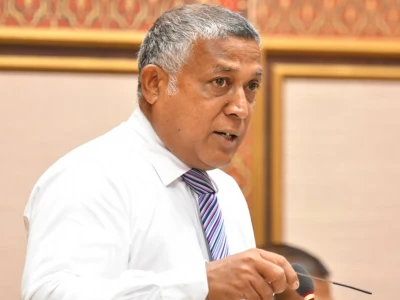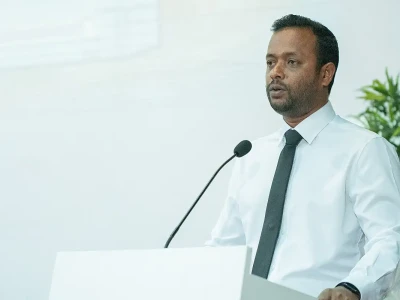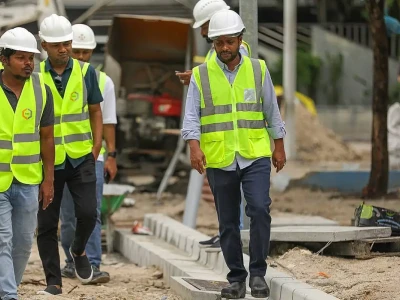
Ameenee Magu EIA: Many violations, much lost
The damaging projects ordered by EPA to be halted after the EIA was done have been carried out with the permission of environment ministry.
Top Stories
By
Shahudha Mohamed
Environmental Impact Assessment (EIA) report for Ameenee Magu redevelopment project has proven that the Environment Protection Agency (EPA) had approved the project before work details had been finalised.
Under the Male Streetscaping Project, Road Development Corporation (RDC) began work on Ameenee Magu on August 30. As part of the MVR 84 million project, trees on Ameenee Magu are being uprooted.
Public onlookers had grown disgruntled with the tree removal. Later, the EIA report that certified the project was leaked on Twitter.
Highlights of the EIA:
-
The final designs of Ameenee Magu water drainage system to be established in the redevelopment had not been attached with the EIA.
-
RDC has proposed to plant trees such as Jacaranda and Neem trees, which are known for their invasive roots.
-
RDC had decided to hand over the road development project to another contractor.
No plan for water drainage system
Since the concept design of the water drainage system has not been included in the EIA, there is room to believe that the system has not yet been designed. If so, RDC had begun removing the trees on the road before completing the road development plan.
Ameenee Magu is an old road, with many potholes and uneven paving, flooding every time it rains. The public is expressing concern that if a proper water drainage system is not established in the redevelopment, the objectives of the project will not be achieved at all.
Noting that it takes a long time for water to drain through asphalt roads than paved roads, Co-Founder of Zero Waste Maldives NGO Ahmed Afrah Ismail said that if the water drainage system is not properly designed, the issue of flooding on Ameenee Magu would get worse.
According to the EIA, the Maldives Water and Sewerage Company (MWSC) had noted that there were problems with the drawings submitted by RDC and had noted that the road below the surface was unknown territory. The concerns of the national water company were shared with RDC, stating that if an underground water pipe is blown up, it will be difficult to repair under asphalt.
The EIA had advised:
-
To complete the design and drawings of the water drainage system after discussing with all stakeholders and on the advice of relevant experts.
-
To consider the city layout when designing, so as to not cause issues with any adjoining streets.
-
Design the road in light of the amount of rainfall and seasonal changes that have taken place in the past years.
Proposed trees can damage road
In a statement, RDC said earlier this week that although Ameenee Magu was to be developed environmentally friendly, there were many challenges in carrying out the renovation of the road as it had underground water pipes, sewerage and other networks.
"Roots of the existing trees have already caused considerable damage to the cable lines underground," he statement read.
However, RDC has initiated the plantation of Jacaranda, a tree native to South America. RDC has planned to introduce to the Maldives a species of this tree imported from India for this project. The Jacaranda tree is known for its strong, extensive rooting that will definitely destroy cables, pipelines and sewerage networks underground.
RDC also proposed to plant Neem, Guava, Sapodilla, and Java-apple trees on Ameenee Magu. Neem is also a tree that spreads its roots extensively, so EPA had advised RDC to replace Neem with Mango in its report.
The EIA advised:
-
Re-vegetation management plan to be developed
-
Planting trees that have matured
When the public started expressing concern over the felling of the trees on Ameenee Magu, RDC responded saying that the trees will be relocated to the reclaimed island of Kudagiri, which is being developed as a picnic island for the locals. However, the company did not share how it was planning on doing it.
When Atoll Times reporters arrived on scene near Dharubaaruge, the trees there were all taken down; branches completely stripped. There were no trees being uprooted and prepped for a relocation. The photos circulating on social media show similar images, all the branches cut down and the trees badly damaged.
The EIA stated:
-
Trees should not be removed unless there is no other choice.
-
Trees must be removed under the supervision of an experienced and capable person to minimise damage to the trees
-
Record of every tree should be kept in portfolio style.
-
Trees must be removed by digging 3 feet away from the base.
-
Trees must be removed after properly watering the roots, and stay that way throughout their relocation process.
Another company assigned
According to the EIA, RDC will award all "construction" works of the project to another contractor. Accusing it of facilitating corruption, some have questioned whether the RDC's role in redeveloping Ameenee Magu was only as an observer.
Local activists working for environmental conservation are expressing concern over the fact that the project is not being carried out in accordance with the regulations. They said that it is against policy to accept an incomplete EIA.
It is common in the Maldives today to carry out development projects in violation of established policies. Land reclamation projects in Addu and Mathikomandoo are two such examples. The damaging projects ordered by EPA to be halted after the EIA was done have been carried out with the permission of the environment ministry.




